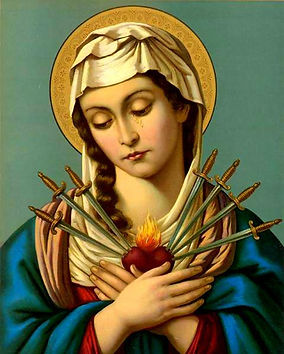
OUR LADY OF SORROWS
Saint Mary Basilica promotes devotion to Our Lady of Sorrows as the patroness of Mississippi, recognizing the profound union between the Suffering Christ and His Most Blessed Mother. She is a beacon of hope and comfort amidst all our anxieties. Now, her joys and sorrows are perfectly consummated in heaven; but as Mother of the Church, her maternal love still extends to us on earth. Here at Mary's House, you can experience the loving embrace of our sorrowful Mother.
PERPETUAL NOVENA PRAYER
Each Saturday, Mass at the Basilica is offered in honor of the Most Blessed Virgin Mary and concludes with the prayers and devotions of our Perpetual Novena to Our Lady of Sorrows, during which we recall all the prayer requests the Basilica has received and present them to the intercession of Our Lady. You may join in this novena by your own recitation of the Novena Prayer:
O MOTHER most holy and sorrowful, Queen of Martyrs, you who stood by your Son as He agonized on the cross; by the sufferings of your life, by that sword of pain that pierced your heart, by your perfect joy in heaven, look down on us kindly as we kneel before you, sympathizing with your sorrows and offering you our petitions with childlike trust. Dear Mother, since your Son refuses you nothing, ask of His Sacred Heart to mercifully grant what we ask, through the merits of His sacred passion, along with those of your sufferings at the foot of the cross. Remind Him that you are our sweetness, our life and our hope, and our prayers will be heard. Amen.

Why 'Our Lady of Sorrows'?
From the early days of Jesus’ life, Mary suffered through these maternal pains and anxieties. With Simeon’s prophecy, Mary knew that a sword would pierce her own soul. Soon thereafter, the Holy Family was forced to flee to Egypt in order to save Jesus from King Herod (Matthew 2:13-23). Also, the Blessed Mother and St. Joseph suffered the pain of Jesus remaining behind in the Temple for three days. With her Son entering upon His Mission the opposition of so many to Him, as recounted in the Gospels, must have been a tremendous sorrow for her. All of this culminated at the Cross.
The title “Our Lady of Sorrows,” therefore, honors the trials that the Mother of the “Suffering Servant” (Isaiah 52:13-53:12) faced, and, therefore, this feast follows immediately after the Exaltation of the Holy Cross.
What was the prophecy of Simeon?
God has never left His people without prophets, individuals like the old man Simeon, whose prophecy regarding Mary is recounted in Luke’s Gospel (2:25-35):
Now there was a man in Jerusalem, whose name was Simeon, and this man was righteous and devout, looking for the consolation of Israel, and the Holy Spirit was upon him. And it had been revealed to him by the Holy Spirit that he should not see death before he had seen the Lord’s Christ. And inspired by the Spirit he came into the temple; and when the parents brought in the child Jesus, to do for him according to the custom of the law, he took him up in his arms and blessed God [...] and said to Mary his mother, “Behold, this child is set for the fall and rising of many in Israel, and for a sign that is spoken against (and a sword will pierce through your own soul also), that thoughts out of many hearts may be revealed.”

THE SEVEN SORROWS
1. The prophecy of Simeon
2. The flight into Egypt
3. Loss of the Child Jesus for three days
4. Mary meets Jesus on His way to Calvary
5. Crucifixion and Death of Jesus
6. The body of Jesus taken from the Cross
7. The burial of Jesus
St. Alphonsus Liguori wrote in his book, The Glories of Mary, of four blessings Our Lord would grant to those who meditate on the Seven Sorrows:
“That those who invoke the divine mother by her sorrows, before death will merit to obtain true repentance of all their sins.”
“That He will protect such in their tribulations, especially at the hour of death.”
“That He will impress upon them the memory of His passion, and that they shall have their reward for it in heaven.”
“That He will commit such devout servants to the hands of Mary, that she may dispose of them according to her pleasure, and obtain for them all the graces she desires.”

